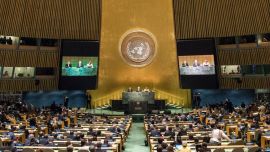President Mauricio Macri’s inspirational and face-saving electoral comeback still does not alter the basic fact that he is out of office come December. Congress is another story though – cutting the PASO primary gap in half made all the difference between a rubber stamp and a hung Congress ensuring more pluralism.
Far from the expected landslide, Frente de Todos was struggling to be the biggest Chamber of Deputies caucus on election night, not to speak of commanding an overall majority.
The election’s winners can aspire to a Senate majority of sorts once the Justicialist and Victory Front caucuses, hitherto divided over Kirchnerismo, merge – although that majority would then hinge on the likes of Catamarca Peronist Dalmacio Mera, who has much more time for Consenso Federal candidate Roberto Lavagna than for president-elect Alberto Fernández, never mind his running-mate.
The size of the Kirchnerite majority of the 24 Senate seats at stake last Sunday depends on whether their unconditional allies of the Santiago del Estero Civic Front are included (15) or not (13). But in any case only 19 of the 72 senators at most are firmly aligned with the new Senate head, Cristina Fernández de Kirchner. Of the other nine senators-elect, eight enter as Juntos por el Cambio (even if two are recent recruits) along with outgoing Juntos Somos Río Negro Governor Alberto Weretilneck.
Most hung parliaments are normally the result of a third party or various minor forces holding numerous seats. This w i l l not be the case in Argentina’s future lower house – of the 257 deputies less than 20 belong to neither Frente de Todos nor Juntos por el Cambio. Two of Lavagna’s main stalwarts – his son Marco and Salta’s Pablo Kosiner, aligned with his running-mate outgoing Governor Juan Manuel Urtubey – lost their seats while the left suffered a rare shutout nationwide.
With over 90 percent voting for the two main forces in Buenos Aires City, for example, there was no room for anybody else – an unprecedented reductionism in this sophisticated metropolis. The extreme polarisation causing this parity thus worked out as a strategy in Macri’s favour at the legislative level in a way it did not in presidential voting.
Indeed the deputies elected for third parties were so few that space permits us to name them, unlike the main blocs, especially if we group the three Santiago del Estero Civic Front deputies as belonging to Kirchnerismo in all but name.
Lavagna lacked the coat-tails for his son in the Capital but Graciela Camaño and Alejandro ‘Topo’ Rodríguez found room among the 35 deputies for Buenos Aires Province with Enrique Eloy Estévez in Santa Fe, giving Consenso Federal three seats. Various provincial governments ran their own lists against the main alliances but only three landed deputies – Córdoba (Carlos Gutiérrez, representing Peronist Governor Juan Schiaretti), Misiones (Diego Sartori) and Río Negro (Luis Di Giácomo) – while a fourth (Mabel Caparrós) responds to Tierra del Fuego’s gay governor-elect Gustavo Melella, who has distanced himself from Frente de Todos only four months after winning as a K Radical.
No less than 19 of the 24 districts shunned any third party. And no less than 120 of Sunday’s 130 new deputies ran directly under the labels backing the current and future presidents – 64 for Frente de Todos and 56 as Juntos por el Cambio (19-14 in Buenos Aires Province).
Yet both sides are precarious coalitions rather than solid parties. Here we will divide these coalitions into four main strands for Frente de Todos and three for Juntos por el Cambio, although even this is an oversimplification. The 64 Frente de Todos deputies-elect fall broadly into four main categories, which still exclude at least three seats – the La Cámpora ultraKirchnerite militant youth grouping; other Kirchnerites and/or leftists, including Movimiento Evita, Victoria Donda, Fernando “Pino” Solanas and others sharply critical of the Cristina Fernández de Kirchner administration at one point (as was Alberto Fernández); those responding directly to Peronist provincial governors (and hence to the future president); and the residue of Sergio Massa’s Renewal Front.
The 64 break down into 12 for La Cámpora, 24 for other Kirchnerites/left-wingers, 17 for the governors and eight for Massa with three more eluding all four categories. Much is written about La Cámpora dominance of the caucus but their dozen deputies are doubled by others even within ha rd- core K irchner ism. However, the bottom line here is that 36 of the new deputies broadly lean towards the future vice-president and only 28 to the next president.
Macri’s coalition is composed of his own PRO centre-right party, the historic Radicals and the Civic Coalition led by the soonto-be-retired Elisa Carrió. Here the breakdown of the 56 Juntos por el Cambio deputies elect is 25 for PRO, 20 Radicals and seven for the Civic Coalition with four more deputies beyond these three parties – Córdoba’s Luis Juez and Peronist allies in La Rioja, San Juan and Tucumán. These numbers are less decisive than Macri improving his PASO primary performance by some two million votes, which should confirm his opposition leadership for now.
Adding these 130 seats to the 127 elected in the 2017 midterms, we see the paradox of Juntos por el Cambio, combining loss of the presidency with emergence as top caucus in the lower house, at least thanks to the rebound from the shock PASO disaster. Defending 46 seats, Macri’s coalition won 56 to finish with 120 seats against 107 for Frente de Todos despite even bigger gains (renewing 39 deputies, they elected 64) while also adding 14 previously non-Kirchnerite Peronist seats.
Many media outlets give the Kirchnerite total as 110, by including their Santiago del Estero allies, or even a maximum of 120 when including various fragments and provinces within the Peronist orbit. Centre-right Peronism (basically four Córdoba deputies responding to Schiaretti) and Lavagna’s Consenso Federal each have five deputies now. The FIT left is now down to two deputies while the remaining 15 deputies (of whom 10 can be considered Frente de Todos satellites) are all single members with no party colleagues, usually provincial in outlook.
In the Senate, Cristina Fernández de Kirchner falls nominally short of an overall majority but the two Santiago del Estero senators take her over the top to 37 of the 72 senators, while the only two Peronists still outside the fold are looking isolated. Cambiemos offers a solid opposition with 29 of the remaining 33 senators but with scant scope for adding to their numbers.
The traditional Peronist
control of the Senate thus
continues, but it takes
two to pass laws, as well
as to tango, and the insufficient lower house
numbers will be a
challenge for Alberto
Fernández. related news





















Comments